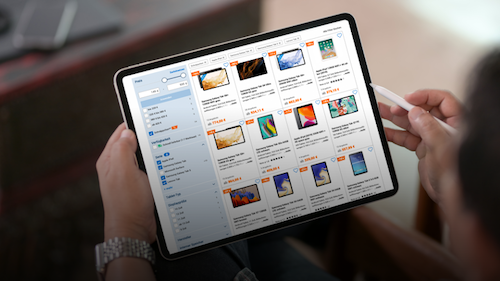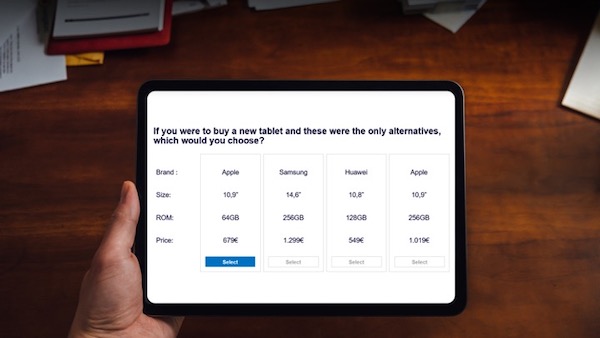What is advanced conjoint analysis?
Editor’s note: Stephan Basson is content marketing manager at market research firm Factworks, Berlin.
You’ve done it. You’ve just thought of the next big thing. Now you need to ask yourself, how can I position this product so its particular novelty is noticed and secures its place in the market? What features or attributes should it have to attract the most customers and, most importantly, what should the price of the product be? In this article I will cover how to answer these critical business questions through advanced conjoint analysis.
What is conjoint analysis?
Conjoint analysis is generally considered the gold standard for product and pricing decisions. Conjoint experiments simulate the buyer experience whereby consumers consider all the features of a product and compare them to those of other products before making a purchasing decision.
By contrast, if you ask respondents to rate which features of a product they see as important, it’s likely that you may not get very discriminating results. Respondents might even rate all the features as important, resulting in very few realistic implications.

Conjoint surveys instead ask respondents to choose between product alternatives with different features and prices. Just like in real life, respondents need to make trade-offs to decide which product is best and if they would even buy any of them, allowing researchers to determine which features respondents truly value.
However, predictions about consumer behavior become difficult when the product landscape or category is highly complex. In these instances, creating realistic choice scenarios help respondents make realistic trade-offs. The challenge is, how do you mimic these choice scenarios in survey design with all the complexities that make up the modern, user-friendly online shopping experience?
The modern decision-making process Is becoming increasingly complex
E-commerce sites offer shoppers a plethora of products at the touch of a button, all in a single view. To accommodate the many consumers who use their mobile devices to shop online, user interfaces have also become more flexible to handle the complexity on both small and large screens.
On these digital interfaces, customers can simply browse through various brands and use filters to easily narrow their search to find the products with their favorite set of features in their preferred price range.
When it comes to payment, there is also more complexity as businesses have started to explore various pricing models and strategies, including pay-per-use, subscription plans, bundles, promos and discounts.

Standardized conjoint exercises don’t visually represent this complexity and often convey an oversimplification of reality. Some simple choice screen designs don’t feature visual aids. Instead, they rely on text-heavy tables, which can lead to cognitive overload for respondents. When choosing standard conjoint exercises, consider if the survey design reflects realistic choices.

If the answer is no, consider incorporating additional elements of the real-life shopping experience in the user interface of the experiment.
How to mimic online shopping complexity in a survey
To mimic the complexity of the online shopping environment, consider creating experiments that:
- Match the user interface of the experiments to a typical online store.
- Can show respondents a vast product landscape.
- Include product pictures and visual cues to aid decision-making.
- Are responsive and sort products based on what respondents chose in previous questions.
- Incorporate discounts and promotions.
- Add filters to help respondents narrow their search as they would in real life.
Adding each of these elements assists in making the conjoint experiment more realistic, which potentially improves respondent engagement as the study becomes more interesting and relevant to them. You may also increase the likelihood that the choices made in the study mirror customer behavior from real-world shopping situations, improving data quality and resulting in more actionable insights for businesses.

Replicating a realistic choice environment: A smart display case study
We followed this realistic choice experiment approach to help inform the pricing and discount strategy for a client operating in the highly competitive online shopping environment of smart displays like Google Nest Hub and Amazon Echo.
Our client wanted to know which innovations, features and promotions help to capture the attention of customers on online shopping platforms and lead them to make a purchase.
To answer this research question, we designed a responsive experiment that featured a vast product landscape, which respondents could browse to find their preferred product. Added search filters and sorting options – as found in real online shops – made it easier to navigate for the participants while also capturing valuable information on their search and decision-making process.
Implementing these filters and registering how respondents use them resulted in substantial learnings about how customers navigate a product category. For instance, we looked at which criteria are most critical for homing in on a relevant short list of options, which brands they exclude or which budget thresholds they set for themselves.
The experiment was also adaptive in other ways, for example, it placed specific brands, product types and promotions respondents previously showed an interest in at the top of the list of products.
By replicating a realistic choice environment, we could see how different devices competed against each other and how promotions and discounts influenced respondents' choices.
One of the main insights was a deeper understanding of the dynamics between MSRP (list/sticker price) and different forms of discounts (e.g., percent and dollar cash discounts) and promotions (e.g., multi-product bundles and free add-ons). To complement the choice model, we analyzed sales data, pricing and promotions in the market over the past year to make an effective pricing strategy recommendation that maximizes the impact of the different pricing components.
The shopping environment continues to change with digitization adding more and more complexity to the terrain. To continue measuring or predicting consumer behavior and preferences needs, you must account for these new realities.
